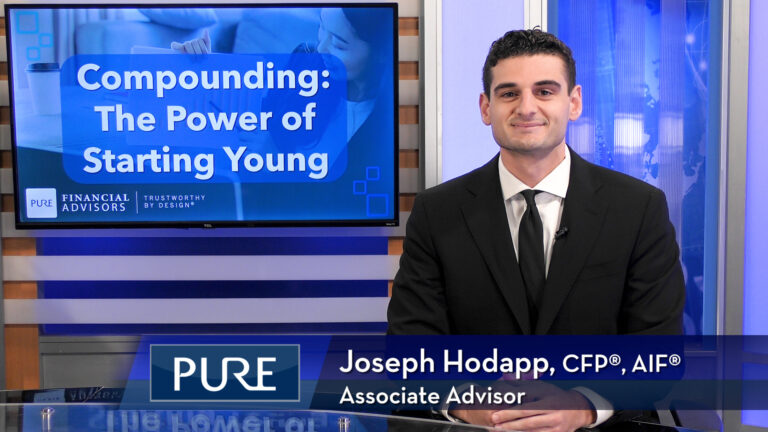As year-end approaches, many look to maximize tax deductions through charitable giving. Donating highly appreciated assets, such as stocks or real estate, through a charitable remainder trust (CRT) is an effective strategy. Pure’s Financial Advisor, Michael, CFP®, AIF®, highlights how CRTs offer tax and estate planning benefits while allowing you to support a cause you care about.
Transcript
As we close in on the end of the year, many people are looking for ways to maximize their tax deductions. Often people think about charitable giving as a way to boost those deductions. While there are many ways one can donate, one effective strategy for donating highly appreciated assets such as stock or real estate is through a charitable remainder trust.
A charitable remainder trust is a type of trust that allows a person to donate assets to charity while retaining the right to receive income from those assets for a certain period of time. After the specified period of time, the remaining assets in the trust are given to a charity of the donor’s choice.
The donor, or grantor, is typically eligible for a charitable income tax deduction in the year the trust is created, based upon the present value of the assets that will eventually go to charity. When appreciated assets (such as stocks or real estate) are placed into the charitable remainder trust, the sale of assets within the trust is not subject to capital gains tax, allowing for the full value of the assets to be invested and grow over time.
The grantor or other designated beneficiaries can then receive income from the trust, typically in the form of either a fixed percentage or a fixed dollar amount, for a period that can last for the lifetime of the grantor, a set number of years, or another defined term.
After the term ends, the remaining funds, which have to be at least 10% of the projected remainder value must go to the charitable beneficiary.
Charitable remainder trust terms can be arranged to be relatively flexible. Beneficiaries may have the ability to adjust the timing and size of distributions received from the trust. This flexibility allows beneficiaries to adapt their income stream as their needs change over time.
When the SECURE Act was passed in 2019, the rules for distributions to beneficiaries of retirement plans, such as IRA’s, were changed significantly. With the exception of a very few types of beneficiaries, most now have to fully distribute inherited IRA’s by the end of 10 years following the account holder’s death.
Another potential strategy that charitable remainder trusts offer is to name the charitable trust as the beneficiary to the IRA. This allows beneficiaries of the charitable trust to receive income distributions from the trust over a specified term, reducing the immediate tax impact compared to what they’d see with a direct inheritance or a mandated 10-year inheritance. This setup can be particularly advantageous for larger IRAs, where direct distributions might push beneficiaries into higher tax brackets.
Key Takeaways:
- The trust must be irrevocable, meaning the trustor gives up all rights of ownership.
- The income tax deduction limited to 30% of AGI.
- The trust can pay out for a set number of years, up to 20 years, or for the lifetime of one or more recipients.
- The trust must pay out at least 5% and no more than 50% annually.
- The remainder interest in the trust must be at least 10% of the fair market value of the initial trust corpus.
- There are legal expenses to establish with trusts plus annual maintenance expenses.
While charitable remainder trusts can offer many estate and tax benefits, its important to understand that they may also come with their own set of complexities in setting up and maintain over time. If you have questions or want to see if a strategy like this makes sense for you, reach out to our team to setup your free financial assessment.
Subscribe to our YouTube channel.
IMPORTANT DISCLOSURES:
• Investment Advisory and Financial Planning Services are offered through Pure Financial Advisors, LLC, a Registered Investment Advisor.
• Pure Financial Advisors LLC does not offer tax or legal advice. Consult with your tax advisor or attorney regarding specific situations.
• Opinions expressed are subject to change without notice and are not intended as investment advice or to predict future performance.
• Investing involves risk including the potential loss of principal. No investment strategy can guarantee a profit or protect against loss in periods of declining values.
• All information is believed to be from reliable sources; however, we make no representation as to its completeness or accuracy.
• Intended for educational purposes only and are not intended as individualized advice or a guarantee that you will achieve a desired result. Before implementing any strategies discussed you should consult your tax and financial advisors.
CFP® – The CERTIFIED FINANCIAL PLANNER™ certification is by the Certified Financial Planner Board of Standards, Inc. To attain the right to use the CFP® designation, an individual must satisfactorily fulfill education, experience and ethics requirements as well as pass a comprehensive exam. Thirty hours of continuing education is required every two years to maintain the designation.
AIF® – Accredited Investment Fiduciary designation is administered by the Center for Fiduciary Studies fi360. To receive the AIF Designation, an individual must meet prerequisite criteria, complete a training program, and pass a comprehensive examination. Six hours of continuing education is required annually to maintain the designation.











